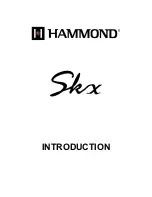
Sequencer P2: Track Parameters 2–2: OSC
469
This setting does not limit the
Unison
Number of
Voices
parameter. For instance, if
Max # of Notes
is set
to
6
, and
Unison
Number of Voices
is set to
3
, you can
play up to 6 notes, each with 3 Unison voices.
If the Program is set to
Double
, the
Max # of Notes
applies equally to both Oscillators. For instance, if
Max
# of Notes
is set to
4
, you can play up to 4 notes on
each OSC
.
Chord
Chord
[PRG, Off, Bsc, Adv]
PRG
uses the Program’s setting. If the Program is set
to
Off
, then the Chord SW has no effect.
Off
disables the Chord function.
Bsc
(Basic) re-creates the chord mode of the original
Polysix. Each time you play a new chord, it will cut off
the previous chord. This option ignores the Voice
Assign settings.
Adv
(Advanced) uses the Program’s Voice Assign
settings, as if each note in the chord was a transposed
set of oscillators layered within the Program.
Poly, Poly Legato, Single Trigger, Mono, Mono Legato,
Legato Offset, Mono Priority, and Mono and Poly
Unison all apply.
You can achieve the same effect as
Bsc
, above, by
setting
Chord
to
Advanced
,
Voice Assign
to
Mono
,
Priority
to
Last Note
, and
Legato
to
Off
.
For more information, see “Using Chord mode” on
page 49 of the Operation Guide.
Source Pad
[PRG, 1...8]
Chord mode uses the chords assigned to the Pads. This
selects which of the Pads to use. You can also select
chords using the Pads themselves; for more
information, see “Using Chord mode” on page 49 of
the Operation Guide.
PRG
uses the notes of the chord stored in the Track’s
Program, instead of any of the chords in the Combi.
This makes it easy to use Chord mode for sound-
specific effects, such as octaves, stacked fifths, and so
on. When set to
PRG
, the Track will not change chords
in response to the pads.
Track 02…16 (Track Number)
Here you can make OSC settings for MIDI tracks 2
through 16. These are the same as for track 1. See
“Track 01:”.
▼
2–2: Page Menu Commands
The number before each command shows its ENTER +
number-key shortcut. For more information on these
shortcuts, see “ENTER + 0-9: shortcuts for menu
commands” on page 138.
• 0:
Memory Status
. For more information, see
• 1:
Exclusive Solo
. For more information, see
• 2:
Rename Song
. For more information, see
• 3:
Delete Song
. For more information, see “Delete
• 4:
Copy From Song
. For more information, see
• 5:
Load Template Song
. For more information, see
“Load Template Song” on page 524.
• 6:
Save Template Song
. For more information, see
“Save Template Song” on page 525.
• 7:
FF/REW Speed
. For more information, see
• 8:
Set Location
(for Locate Key.) For more
information, see “Set Location (for Locate Key)” on
page 525.
• 9:
GM Initialize
. For more information, see “GM
• 10:
Copy From Combination
. For more
information, see “Copy from Combination” on
page 526.
• 11:
Copy From Program
. For more information, see
Summary of Contents for Electronic Keyboard
Page 1: ...Parameter Guide Parameter Guide ...
Page 2: ......
Page 180: ...Program mode EXi 170 ...
Page 290: ...EXi STR 1 Plucked String 280 ...
Page 572: ...Sequencer mode 562 ...
Page 700: ...Global mode 690 ...
Page 751: ...Insert Effects IFX1 IFX12 Routing 741 Fig 2 3a Fig 2 3b ...
Page 902: ...Effect Guide 892 ...
















































